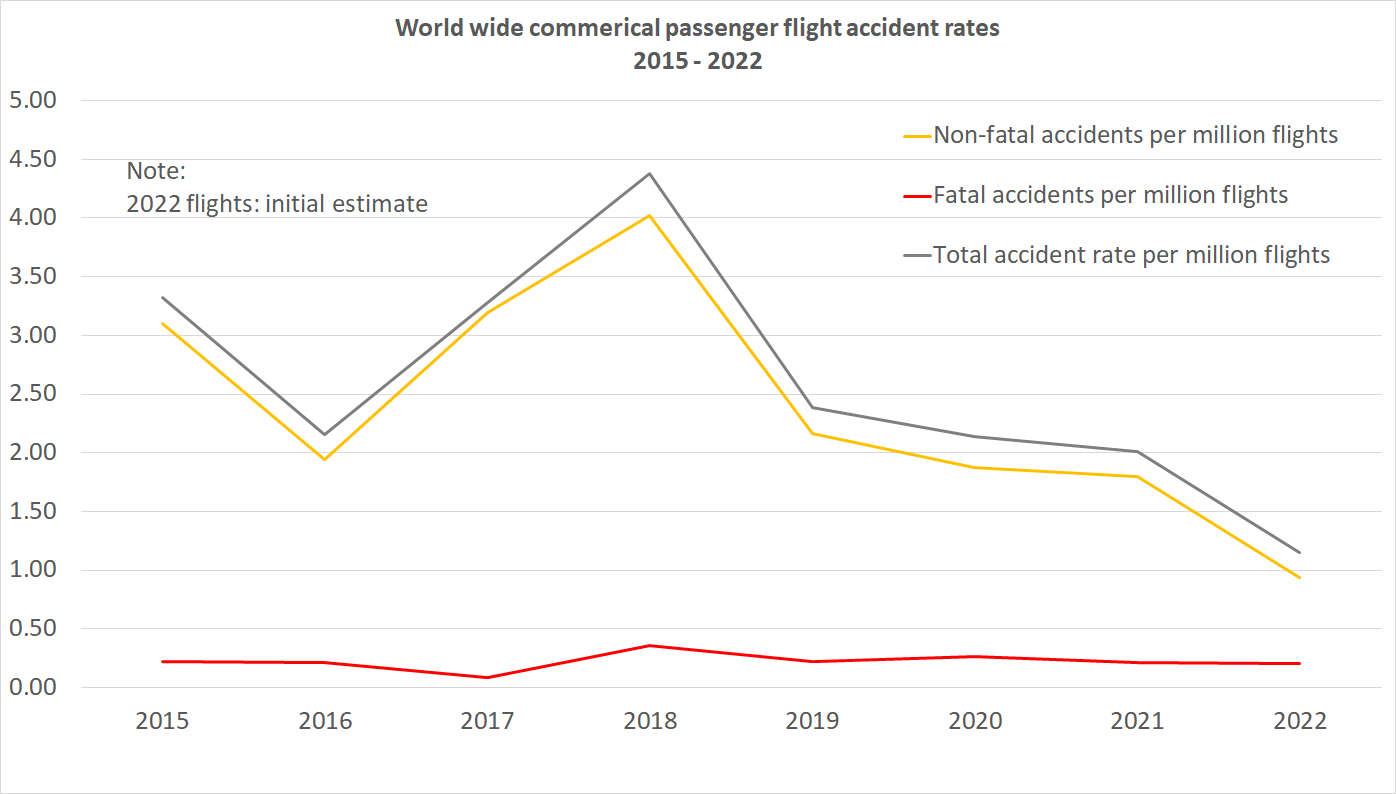Most fatal accidents in 2022 have known mitigations from past accidents
by Adrian Young 1 January 2023 to70
The post-COVID recovery that everyone expected came in 2022. Whilst it was a difficult summer with capacity issues at airports, leading to long queues at terminals, the recovery has not resulted in a higher accident rate – neither in general or to the rate of fatal accidents to large passenger aircraft flights. The flight numbers show that passenger flights are almost back at pre-COVID levels; on individual days at some airports, the 2019 figures for flights and passengers were exceeded.
Much good work, performed thorough 2021 and early 2022, to highlight the need for extra care when operations started to ramp up again appear to have paid dividends. We reported on the initiatives in our 2021 air safety review and what we reported then, remains valid today.
2022 has been a year with a lot of focus on sustainable flight and airport operations. To date, developments in this field have not had an impact on safety. However, future developments may well require careful scrutiny to ensure that we do not introduce new risks to civil aviation.
A low fatal accident rate
As ever, the To70 civil aviation safety review examines accidents only to larger passenger aircraft used by most travellers. (See our criteria in the Note below.) We include all causes, whether technical failure, human error or unlawful interference. In 2022 there were 34 accidents, 7 of which were fatal, resulting in 179 fatalities. In 2021 there were 38 accidents, 4 of which were fatal, resulting in 81 fatalities. The fatal accident rate for large aeroplane in commercial air transport is 0.24 fatal accidents per million flights, compared with 0.21 per million in 2020. This is a rate that is within the 0.20 – 0.25 fatal accidents per million flights that we have – with the exception of 2017 (lower) and 2018 (higher) – seen since 2015. The current rate of one fatal accident every four and a quarter million flights and this years’ fatal accident rate is better than average over the last 10 years.
The fatal accidents to large passenger aircraft in 2022 were:
| Date (2022) | Type | Operator | State of Registration | State Accident occurred | Fatalities |
| March 21st | Boeing 737-800 | China Eastern | China | China | 132 |
| May 29th | DHC 6 Twin Otter | Tara Air | Nepal | Nepal | 22 |
| September 2nd | Airbus A320-200 | TAP | Portugal | Guinea | 2[1] |
| September 20th | Jetstream 32 | SAETA Peru | Peru | Peru | 1 |
| November 6th | ATR 42-500 | Precision Air | Tanzania | Tanzania | 19 |
| November 18th | Airbus A320-200 | LATAM | Peru | Peru | 21 |
| December 31st | Embraer 175 | Piedmont Airlines | USA | USA | 11 |

2022’s accidents were mainly of known accident types to which mitigations exist
With the exception of the accident to the Chinese Boeing 737 in March 2022, in which 132 people lost their lives, most of the accidents in 2022 relate to known types. These include hard landings, tail strikes and runway excursions. The Tara Air[2] accident in Nepal relates, it appears from the information available at the time of writing, to a controlled flight into terrain accident.
In three of the fatal accidents, the fatalities were to persons who were not on board the aeroplane. In an accident at Conakry airport, Guinea, two persons on a motorcycle entered runway as the Airbus A320 was landing and collided with the aircraft. Both people on the motorcycle died. In the second accident, a fire & rescue vehicle entered the runway at Lima airport in Peru as an Airbus A320 was taking off. In the ensuing collision, two members of the airport’s fire and rescue team were killed. In this accident, the aeroplane was severely damaged and a number of passengers were injured.
It is not clear what the motorcycle was doing on the runway and reports into the event from the Guinean authorities had not been released at the time of writing. The accident involving the fire crew in Peru is the subject to an investigation and a report is expected in 2023.
The last of the three was on New Year’s Eve when a ground handler was reportedly sucked into the engine of an aeroplane prior to departure.
Using material prepared by Airbus[3] most accidents fall into one of seven types:
- Controlled flight into terrain (CFIT)
- Loss of control in flight (LOC-I)
- Runway excursion
- Fire
- Abnormal runway contact
- Undershoot / overshoot
- System / component failure or malfunction
In 2022, four of the seven fatal accidents fell into one of these categories. There was one CFIT accident, one LOC-A accident, a runway incursion and an undershoot. The three accidents that resulted in the deaths of third parties do not fit into the above types.
One trend in 2022 that might, we stress, might, relate to a loss of skills following the COVID lockdowns, relates to ground handling. Three of the accidents, all non-fatal, involved ground handling equipment striking aircraft with a force to seriously damage them. An airbridge, a baggage belt and a set of stairs were involved in the three incidents; two in Europe and one in the US. In the course of researching the safety survey, a number of other incidents in which ground equipment collided with the aircraft were also noted.
Methodology
To70 uses official figures reported by States to the UN’s aviation agency, ICAO, to determine the number of civil aviation flights that have taken place in any given year. The actual figures, published by the air transport organization, IATA, are used to estimate the current year’s figures. We update our database each year when the actual flight numbers data for the previous year becomes available.
Accident data is derived from publicly-available databases, aviation authority websites and official sources such as ICAO’s ADREP database. Our analysis documents accidents to passenger flights commercial air transport operations in aeroplanes with a maximum take-off mass of 5700 kg or above. This excludes a number of small commuter aeroplanes in service around the world, including the Cessna Caravan (maximum take-off mass 3629 kg). Certain relevant exceptions may be included regarding smaller turbo-prop aeroplanes just below this mass limit (e.g., the De Havilland Twin Otter with a maximum take-off mass of 5670 kg). Accidents to military flights, training flights, private flights, cargo operations and helicopters are excluded. Unlike statistics produced by IATA and ICAO, accidents involving unlawful interference are included in our analysis.
As the vast majority of commercial air transport operations take place with large aeroplanes, the effect of the excluded types on the accident rate is very small.
Notes
*The cover picture is not an accident photo but is of a fire training exercise on an old aeroplane at Copenhagen Airport
[1] Third parties were killed, not the aircraft occupants
[2] Tara Air is banned from entering European airspace as per the so-called blacklist resulting from U 474/2006.
[3] See https://accidentstats.airbus.com/statistics/accident-categories




